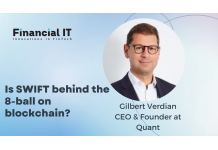Blockchain for Enterprises: Is the Power of Blockchain Mature Enough?

- Agnieszka Hołownia-Niedzielska, Senior Solutions Consultant at Espeo Software
- 03.09.2023 07:00 pm #Blockchain
What is an enterprise-graded blockchain?
The question of whether blockchain technology is mature enough for enterprise use depends on the technology's ability to provide stable, long-term solutions with the necessary scalability.
To answer the question of whether blockchain is enterprise-ready, I have focused on three areas of analysis:
1. The concept of enterprise blockchain
2. The technical maturity of blockchain
3. Enterprise implementations and foreseeable steps in their growth
Let's start by clarifying what an enterprise blockchain is: it's a blockchain with all the standard features, such as immutability, transparency, and a distributed ledger with the ability to send transactions between parties. Most blockchains are also programmable, so all these features are used in chain code/smart contracts that are part of the network. However, enterprise blockchains are defined by their additional features.
What are the aspects of enterprise-graded blockchain that set it apart?
Modular
Complex corporations and medium-sized businesses have needs that require a tailored approach. Modular solutions are like Lego bricks: you can build an aircraft or a submarine using a similar set of bricks, and you can do it without making the plastic bricks yourself. The same approach applies to modular tools, which allow you to use what is already available to create solutions that meet individual needs.
Highly secure
A critical component of any major business decision is the question: Is this secure? With distributed ledgers, security is a challenge. On the one hand, multiple parties do not always trust each other, and blockchain nodes operate in different IT environments. On the other hand, transactional data can be of real importance. Enterprise blockchain requires bulletproof solutions and best practices for network security. This characteristic tends to make organisations prefer private networks over public ones.
Interoperability and systems integration
Enterprise solutions need to talk to each other; there is no place for closed, "all or nothing" approaches. "All or nothing" means that an organisation can either use all the systems from one technology ecosystem, or it has no chance of achieving smooth operations and data flow between solutions. Interoperability is a must for blockchain networks, including blockchain-to-blockchain communication.
Interoperability as a feature of the enterprise network or system helps to implement the solution into the existing IT infrastructure and business processes. Whenever business processes are intertwined, they need to exchange or transfer data from system to system. In the worst case, users manage this manually by copying and pasting. Interoperable tools are ready to connect and communicate with other solutions. As a result, the addition of another IT solution not only smooths the work in the process it is dedicated to, but also in other processes that act as data providers and receivers for the main process.
Complete with application programming interfaces (APIs)
The larger the organisation, the more data sources and dependencies there are. An enterprise-ready solution must be prepared to be accessible to different systems. Fast interfacing with external systems is a critical feature for enterprise blockchain.
Cryptocurrency-agnostic
This last element is a bit tricky - it's one of the points of Hyperledger's design philosophy, although in my opinion it only applies to some enterprise blockchain projects. An agnostic solution is the best approach when there is no token or cryptocurrency in use, or it's not a critical part of the system. There are projects where a token is at the heart of all the functionalities being built. For these projects, choosing a blockchain with a strong focus on the characteristics of the token is the right approach. Enterprise-grade blockchains should often be crypto-agnostic, but there are cases where this does not apply.
Blockchain networks that offer all or most of the features mentioned are called enterprise blockchains. To name a few: Hyperledger Fabric, R3 and QUORUM (enterprise Ethereum implementation). Note that blockchain technology is one side of the coin, how these features are addressed in their specific implementation may be another story. Nevertheless, using enterprise blockchain with qualified blockchain experts can create valuable enterprise solutions.
Is blockchain a mature technology?
Let's take a closer look at what constitutes a mature technology.
There is no single objective definition of maturity, but by mixing a few approaches and creating one compacted version, I have decided to look at the issue from the following angles:
Reliability
A mature technology is reliable and predictable as a tool for building solutions. There are working commercial products using the technology and they have been growing for some time, so they were analysed from different perspectives: security, application and completeness. Enterprise blockchain networks have ecosystems to ensure reliability. For example, the Hyperledger Foundation has an entire Greenhouse, which is a way to support development projects with structure, avoid duplication of effort, and provide quality code control.
The Greenhouse is an initiative that brings together users, developers and vendors interested in using blockchain in the enterprise. The structure incubates new ideas, supports projects and distributes the results widely. The Greenhouse provides an organisational framework to help development teams organise their work and to help companies select technical tools based on their merits in terms of the maturity of the item, its future growth or even information on how the intellectual property for the item will be handled.
Maintenance
Having been accepted by innovators and early adopters, a mature technology should be able to demonstrate its longevity. A transparent project history with proven plans for growth and improvement increases the likelihood that the technology will be more robust and last longer. The goal is to build a solution with tools that can be adapted to modern trends, updated and upgraded.
Community
Community is a modern solution for developing and maintaining better technology. Mature solutions have a wide range of channels to communicate with their community, and everyone can see what is going on and share their opinions. To be clear, a technology community is not the same as an open-source project. For example, we see robust communities around both Microsoft and Ethereum.
Specialists' availability
Mature technology is available. Experts and companies can implement the solution based on mature technology. The skills and capabilities of blockchain IT providers can be independently assessed, thanks to the range of training and certifications available. Thanks to them, qualifications can be obtained and verified in many ways.
It can be observed that more and more universities and schools are providing their students with blockchain knowledge, while enterprise blockchains are offering separate ways to learn about their tools. For example, Hyperledger offers its own courses and cooperates with the online platform edX, while the University of Nicosia offers MSc studies in Blockchain and Digital Currency. Blockchain is no longer a magical secret discovered by a few. The pool of specialists and learning opportunities are as mature as the technology itself.
No paradigm shifts
Mature technology allows solutions to be built without the constant worry that tomorrow the technology will rapidly change and will be no longer sufficient. Mature technology vendors understand that changes must take into account aspects such as backward compatibility and incremental improvements. Blockchain's enterprise-grade networks provide a clear path for growth and adequately publish minor and major changes so that businesses can seamlessly upgrade.
At least a few drops of blood
The research and development (R&D) phase of projects is sometimes referred to as the 'bleeding edge' because of the many pitfalls and high risks of technology proving unreliable, inapplicable or simply too complicated compared to others. Mature technology was originally doubted and challenged, which led to some adjustments and improvements. Without blood, technology has not been challenged enough.
Looking at the features of enterprise blockchain and reviewing the aspects of mature technology, we can see how blockchain technology can become mature. However, is the ability to follow the definition of enterprise blockchain and mature technology enough to declare it enterprise-ready?
What are some examples of enterprise blockchain projects?
Let’s investigate enterprise blockchain implementations in 4 areas:
1. Finance
2. Supply chains
3. Accounting
4. Settlements
Finance
The financial world has been shaken by blockchain technology since its inception. The use of blockchain started with cryptocurrencies but has since evolved beyond investments. One example is the transfer of money between countries. The traditional banking process requires multiple currency exchanges and intermediaries (transfer banks), which can take a lot of time. Numerous companies have tackled the problem of cross-border payments by launching live blockchain networks that enable secure, time-efficient and cheaper money transfers. To name one: JPMorgan's 'Liink project' has been growing for years, and in October 2022, this already mature project entered a new phase after officially joining forces with VISA.
Supply chains
Supply chains are complex systems, with multiple companies and small businesses working together in an environment that can be uncertain. One of the first to seize the opportunity to use blockchain's features, such as equal participation and a single source of truth, was Walmart. Together with IBM, they created a network to bring together distributors and retailers to guarantee the origin and quality of food from producer to store shelf, speeding up the process of tracing provenance from 7 days to 2.2 seconds.
Accounting
Enterprise and middle-size companies put a lot of effort into their accounting processes. Handling contracts and procedures like invoicing can be complex and require multiple parties to be in sync, with the risk of human error that could have unpredictable consequences. With blockchain technology, everyone uses the exact same data source, and various processes resulting from contract execution may be automated thanks to smart contracts. All of the data is in one place, access is controlled, and each participant in the process can easily find out what has been done and at which stage is the process. The immense relief is that multi-channel processes like data gathering, closing periods, or invoicing are automated. The Zurich branch of Aon has implemented its invoicing processes using enterprise blockchain in the insurance sector.
Settlements
Settlements are part of the accounting processes mentioned above and can be a huge task, including settlements between hundreds of partners and branches or subsidiaries. Again, blockchain could provide its out-of-the-box features: seamlessly settle payments, leave immutable data records, and facilitate the payment process. Companies can use blockchain to handle internal commissions and referral programs that can be easily audited, as well as being much cheaper to implement than sending money back and forth. An automated process allows operators to switch from repetitive tasks to handling value-added exceptions and issues where their specialised knowledge is key. Those systems enable multiple partners to work simultaneously, share referrals, and monitor cooperation with clients from a global perspective.
I have been a part of multiple teams that built internal settlement systems working in favour of enterprise-class companies.
Conclusion
Blockchain is more than just a novelty. It is a mature technology with multiple use cases, and it will stay with us long into the future.
However, to mitigate risk it should only stay where it has been proven usable beyond the proof of concept and minimum viable product stages. Not all blockchain projects are or will be, mature. It depends both on the technical and the business side. The technical side of the project needs to be well thought out, planned, and aligned with the strategic needs as the project goes on. A technical plan must include technical dependencies, architecture, and functionalities to be delivered. The business side also needs to be planned and executed with agility in mind. It requires planning time, resources, and requirements gathering, all of which will include multiple stakeholders. Both areas need to think at least one step ahead, as today's decisions determine how we will handle reality tomorrow.
Blockchain is mature and powerful enough to offer outstanding solutions at scale for enterprises. It won't necessarily be easy as blockchain is technologically complicated and the distributed ledger raises new questions around data governance. However, as the results have shown so far, it is worth it.


























